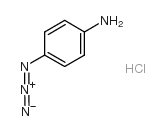4-叠氮苯胺盐酸盐

4-叠氮苯胺盐酸盐结构式

|
常用名 | 4-叠氮苯胺盐酸盐 | 英文名 | 4-Azidoaniline hydrochloride |
|---|---|---|---|---|
| CAS号 | 91159-79-4 | 分子量 | 170.60000 | |
| 密度 | N/A | 沸点 | N/A | |
| 分子式 | C6H7ClN4 | 熔点 | 165ºC (dec.)(lit.) | |
| MSDS | 中文版 美版 | 闪点 | N/A | |
| 符号 |


GHS02, GHS06 |
信号词 | Danger |
|
[Study on immobilization of heparin on surface of Ti-O films and its antithrombogenicity].
Sheng Wu Yi Xue Gong Cheng Xue Za Zhi 28(1) , 86-9, (2011) Photoreactive heparin was synthesized by reaction of 4-azidoaniline and heparin. An organic layer was introduced on the surface of Ti-O by 3-aminopropylphosphonic acid assembling, and then the modified heparin was immobilized on the surface by UV irradiation.... |
|
|
Peptidotriazoles on solid phase: [1,2,3]-triazoles by regiospecific copper(i)-catalyzed 1,3-dipolar cycloadditions of terminal alkynes to azides.
J. Org. Chem. 67(9) , 3057-64, (2002) The cycloaddition of azides to alkynes is one of the most important synthetic routes to 1H-[1,2,3]-triazoles. Here a novel regiospecific copper(I)-catalyzed 1,3-dipolar cycloaddition of terminal alkynes to azides on solid-phase is reported. Primary, secondary... |
|
|
Preparation of a protein micro-array using a photo-reactive polymer for a cell-adhesion assay.
Biomaterials 24(18) , 3021-6, (2003) A protein micro-array, called a "cell chip" was constructed by using a photo-reactive polymer for a cell-adhesion assay. Various amounts of albumin or fibronectin were covalently immobilized on a polystyrene dish using a micro-spotter with a dip pen. First, p... |
|
|
The use of hyaluronan and its sulphated derivative patterned with micrometric scale on glass substrate in melanocyte cell behaviour.
Biomaterials 24(6) , 915-26, (2003) Surface microfabrication techniques were widely utilised for the spatial control of in vitro cell behaviour. A photo-immobilisation procedure was utilised to create micropatterned surfaces: four different stripe patterns (100, 50, 25 and 10 microm) of hyaluro... |
|
|
Enhancing neurite outgrowth from primary neurones and neural stem cells using thermoresponsive hydrogel scaffolds for the repair of spinal cord injury.
J. Biomed. Mater. Res. A 89(1) , 24-35, (2009) In this study, thermoresponsive xyloglucan hydrogel scaffolds were investigated as candidates for neural tissue engineering of the spinal cord. The hydrogels were optimized to provide similar mechanical properties to that of native spinal cord, although also ... |
|
|
Characterization and photoaffinity labeling of a calcitonin gene-related peptide receptor solubilized from human cerebellum.
Biochemistry 30(35) , 8605-11, (1991) Calcitonin gene-related peptide (CGRP) receptors were solubilized from human (h) cerebellum with use of the zwitterionic detergent 3-[(3-cholamidopropyl)dimethylammonio]-1-propanesulfonic acid (CHAPS). Scatchard analysis of equilibrium binding data indicated ... |
|
|
Matrix isolation and computational study of the photochemistry of p-azidoaniline.
Phys. Chem. Chem. Phys. 8(6) , 719-27, (2006) The photochemistry of p-azidoaniline was studied in argon matrices in the absence and presence of oxygen. With the help of quantum chemical calculations we were able to characterize the triplet p-aminophenylnitrene as well as the cis- and trans-p-aminophenyln... |
|
|
Gradient micropattern immobilization of heparin and its interaction with cells.
J. Biomater. Sci. Polym. Ed. 12(4) , 367-78, (2001) Heparin was immobilized on a polystyrene plate in a graded micropattern by photolithography. The micropattern was confirmed by staining with brilliant green. In the presence of basic fibroblast growth factor (bFGF), the growth of NIH3T3 cells was enhanced onl... |
|
|
E. Escher et al.
Helv. Chim. Acta 62 , 1217, (1979)
|
|
|
Signal transduction characteristics of the corticotropin-releasing hormone receptors in the feto-placental unit.
J. Clin. Endocrinol. Metab. 85(5) , 1989-96, (2000) Placentally derived CRH plays a major role in the mechanisms controlling human pregnancy and parturition. In this study, we sought to investigate the signal transduction mechanisms of CRH Type-1 receptors in the feto-placental unit. To clarify the signal tran... |